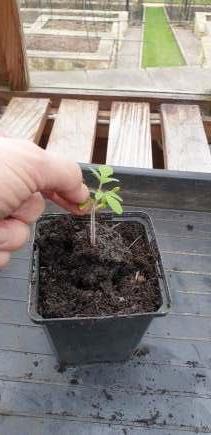
5 minute read
Pricking, drilling and tilth
vi: Garden Gems
Pricking, drilling and tilth
Advertisement
Ruth Crighton-Ward
We’re starting to notice real changes underway, as we head into April. In the garden, things seem to progress on a daily basis. There are still a few frosty mornings but, in general, the air is warmer. Plants have woken from their winter slumber and growth begins to accelerate.
The seedlings we previously planted have now developed their true leaves and need to be put into larger containers. This process of removing young plants from their original trays and containers is called ‘pricking out’. Although not difficult, it does require a degree of patience, as the seedlings are extremely delicate. Use a tool— such as a pricking out fork —to gently tease the roots free, then lift them out by a leaf, preferably one of their dicotyledons. A cotyledon is an embryonic leaf (I have also heard them referred to as pilot leaves) which breaks through the soil after germination, before any other leaves appear on the plant. A dicotlyedon (‘dicot’) produces two such leaves whereas a monocotyledon (‘monocot’) only produces the one. Nearly all bulbs are monocotyledons apart from members of the Oxalidaceae (Oxalis spp).
The photos below show a young Tomato plant (Solanum lycopersicum) being pricked out. When placing the young plant in a new container choose one suitable for its size. Bear in mind you may have to repot it a further couple of times during its lifetime. Do not bury it too deep but do ensure all roots are covered. Be gentle when pressing compost around it, and once the plant is in its new pot remember to give it a thorough watering.



At this point in the year, we can start sowing seeds directly outdoors. Seeds which can be sown now include hardy annual herbs, like German Chamomile (Matricaria recutita), Pot Marigold (Calendula officinalis) and Borage (Borago officinalis). The process is the same whether you are sowing seeds for medicinal, nutritional or ornamental use. So, we’ll need to prepare those beds we previously dug. We want a fine ‘tilth’, which Encyclopaedia Britannica describes as: the physical condition of the soil, especially in relation to its suitability for planting or growing a crop. Factors that determine tilth include the formation and stability of aggregated soil particles, moisture content, degree of aeration, rate of water infiltration, and drainage.
Rake the soil out evenly, breaking up lumps of compacted soil and removing any stones that may impede the seeds. Finally, rake again so that the soil is level.
Next, create a ‘drill’ for the seeds. This is a channel in the soil where the seeds will be sown. The depth of the drill depends on the seed you are sowing. Some require less than a centimetre, while others need to be several inches deep. Make sure to check the required depth for the seeds prior to sowing. Too deep, and the seedlings may never reach the surface or will be spindly and weak when they do. Too shallow, and the seeds could be washed away, or the roots exposed when they germinate. Seeds do not have to be sown in straight, neat rows or blocks. They can be sown in swirls and drifts to create more aesthetic forms. Experiment with the seeds and space you have.
Hardy perennial herbs which are permanently outdoors, such as Chives (Allium schoenoprasum) and Lemon Balm (Melissa officinalis) should now have healthy new growth, but it is still too early to sow tender and half-hardy plants outdoors, although they can be started off indoors.

Having been chitted for a couple of weeks, your potatoes should have small leafy growths coming from them and they can now be planted. Different types of potato grow at different speeds. Those which take less time to grow are called ‘earlies’, and they can be divided into ‘first’ and ‘second earlies’. The tubers of earlies (your potatoes) are harvested in early to mid-summer. They tend to be smaller and are used more often for salads. Potatoes which are harvested later in the year are known as ‘maincrop’ varieties. They are bigger and can be left in the ground longer. Potatoes are a favourite for growing; not only are they a versatile, easy to grow food, they store for a long time and are not bothered by slugs. Perhaps the only drawback to growing them is the amount of space they need. There should be 30cm between each potato and 60cm between rows, but if lack of space is a problem in your garden, then they can be grown in sacks or growbags. To plant your potatoes, place them about 12cm deep in the ground and cover them with soil. Later, when the plants are about 20cm high, they will need to be ‘earthed up’. This is the process of drawing soil up and over the potato, forming a ridge. This protects the plant’s leaves from frost— which will turn them black and curly — and protects the tubers from sun damage. If the plants are not covered properly, the potatoes will turn green and be less digestible.
Now that the clocks are going forward, we can enjoy having more light at the end of the day. There is a sense that we won’t have too much longer to wait for warmer weather and evenings outside, and we suddenly realise that the grass is needing cut again. Don’t take it down too short. Give it just a light cut— there are still some frosty nights and mornings which could hamper the new growth. Without warning weeds start to appear. Keep on top of them while they are young, or they become more difficult to deal with later.
Next month, we’ll look at different methods of planting, such as companion planting, and what we can do to benefit the wildlife in our gardens. Enjoy the spring.










